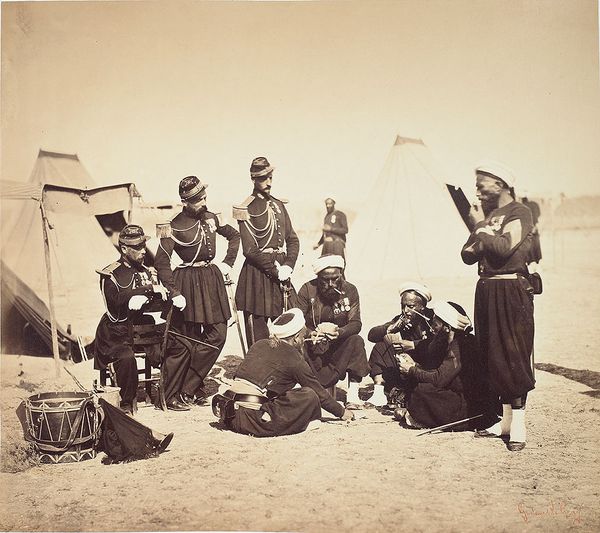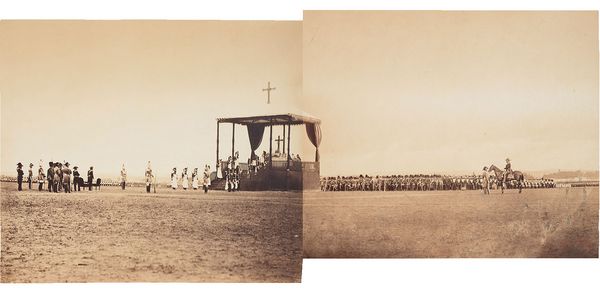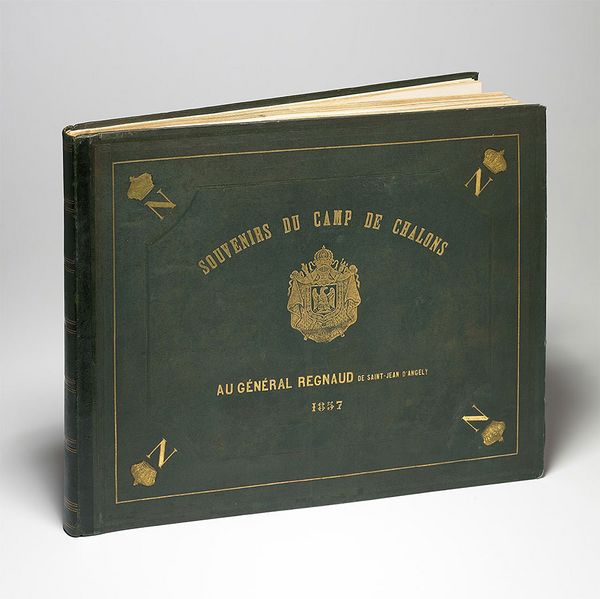Gustave Le Gray, Souvenirs du Camp de Châlons, 1857. Photographs London.
Gustave Le Gray’s Souvenirs du Camp de Châlons is among the best‐known and earliest photographic documentations of military activities. Commissioned by Napoleon III in 1857, the album’s purpose was to record the Emperor’s military camp in Châlons-sur-Marne, a training ground for the French army designed to readdress inadequacies noted during the Crimean War (1853-1856). The camp remained in operation until 1870 and the end of the Second Empire (1852-1870).
Acting as a “historical gallery” and a monument to the Second Empire, Souvenirs du Camp de Châlons, with its poetic rendering of the military camp, showcases the photographer’s unequaled artistic and technical prowess in the early days of photography. In his role as the official photographer for the Imperial Family, Le Gray spent September and October of 1857 at the military camp, mastering the delicate nature of the wet-collodion process under difficult conditions to produce an extensive collection of outstanding images.

Gustave Le Gray, Manœuvres de Cavalerie de la Garde Impériale, 1857. Photographs London.
This exceptionally rare album was given by Emperor Napoleon III to his highest-ranking officer, Comte Auguste Regnaud de Saint-Jean d'Angély (1794-1870), Commander-in-Chief of the Imperial Guard and Marshal of France. With a total of 66 albumen prints (44 scenes and 22 portraits), the Regnaud album contains not only the highest number of scenes of camp life, but also the highest total quantity of prints among the six Camp de Châlons “grands albums” that are believed to be intact and held privately.
The present album, unique in its composition and sequence of images as chosen by Comte Regnaud, follows a rhythmic and carefully selected display of 44 scenes depicting camp activities and the environment, ranging from close-up depictions of Zouave daily life to contemplative landscapes. Horizontal lines, reminiscent of Le Gray’s renowned seascapes, often divide the images into the sky and the earth, offering lyrical representations of men and horses standing in the mist and bathed in soft light.

Gustave Le Gray, Zouaves de la Garde Impériale (Le Jeu de la Drogue), 1857. Photographs London.
Le Gray’s photographs also display the altered landscape of the camp with tracks of horses and men on the ground and the atmospheric quality of the site. The Regnaud album ends on a beautiful and immersive six-part panorama; this technical accomplishment reflects the Emperor’s desire to capture a 360-degree rendering of the camp from his elevated vantage point. The two most exceptional scenes of cavalry maneuvers – Manœuvres de Cavalerie de la Garde Impériale and Manœuvres du 3 Octobre 1857 – a remarkable six-part panorama of the camp, mounted two by two on three double pages, (known to have been favored by the Emperor) and a rare image showing the Emperor on horseback on the day of Mass, and known to have been included in only one other "grand album" (subsequently disbound and dispersed), are featured.
In addition to the scenes, the Regnaud album includes 22 military portraits, featuring officials in full or three-quarter lengths with indications of rank and honors displayed on their uniforms and eight blank pages with handwritten names in pencil indicating missing portraits as observed in other known albums. Also included are reproductions of works by Bénédict Masson and a print by Robert Jefferson Bingham of an 1858 equestrian portrait of Napoleon III by Alfred de Dreux, which was added later by Regnaud as the first image in the album. The Regnaud album has remained in the collection of the family for more than 160 years and was recently rediscovered in a drawer in Regnaud’s home in northern France. It is in excellent condition and has never before been offered for sale. It is believed that this is the most complete Camp de Châlons album to appear at auction.

Gustave Le Gray, La Messe au camp de Châlons and L’Empereur à la Messe au camp de Châlons, 1857. Photographs London.
Academic surveys and our own research suggest that a total of no less than 28 Camp de Châlons albums were created, of which 27 would have been given to the leading men at the camp, and one kept for the Emperor himself (which has never been found). Of the 27 albums believed to have been gifted by the Emperor, the recently discovered Regnaud album brings the total number of albums so far identified to 22. Of the 13 “grands albums” identified, at least three have been disbound and dispersed, leaving ten albums believed to be intact. Of these ten, four are in museum collections and six, including the Regnaud album, are in private collections.
While each Camp de Châlons album is unique in its selection and sequence of images, they all fall under one of two categories: “grands albums” and “petits albums.” Of the 22 known albums, 13 are “grands” and nine are “petits.” The main difference between the two album sizes with regards to the scenes of camp life is that the majority of known “grands albums” contain a total of around 41 scenes whereas the majority of known “petits albums” contain only around 27 scenes in total. Furthermore, the two most sought-after Camp de Châlons scenes – Manœuvres de Cavalerie de la Garde Impériale and Manœuvres du 3 Octobre 1857 – are believed to have been included in all 13 known “grands albums” but only the 3 Octobre image appears in seven of the nine “petits albums” and the Manœuvres de Cavalerie image does not appear in any. In addition to this image, La Messe au Camp de Châlons, Zouaves de la Garde Impériale (Le Jeu de la Drogue), the six-part panorama of the camp and several others appear only in the “grands albums.” Whether an officer received one or the other album, and the quantity of prints contained therein, appear to have corresponded to the military rank of the recipient, adding to the unique scope and completeness of this edition.
Discover More from Photographs London >
Recommended Reading
